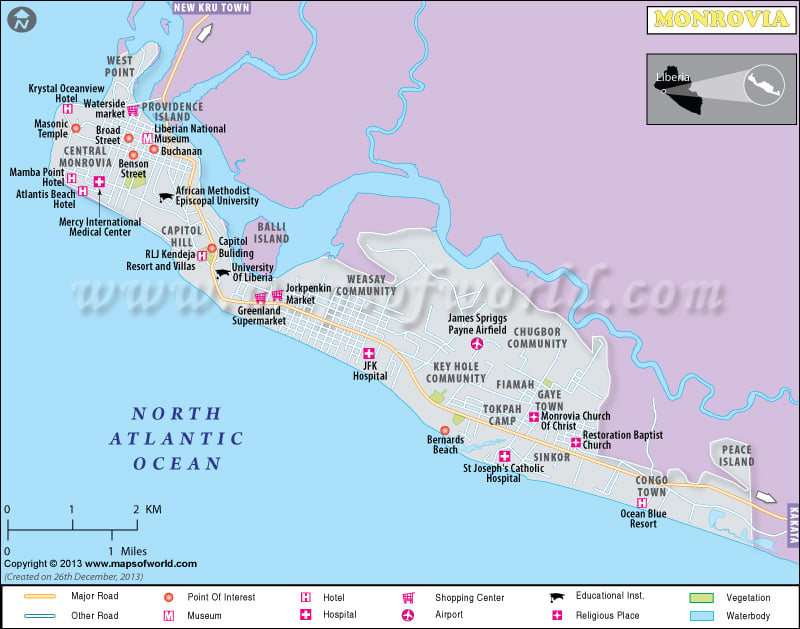Facts About Monrovia |
|
|---|---|
| Country | Liberia |
| State | Montserrado |
| Founded | April 1822 |
| Area | 35.52 km² |
| Population | 970824 |
| Lat Long Coordinates | 6°18′48″N 10°48′5″W |
| Time Zone | UTC+0 |
| area Code | 1000 +231-6511651 |
| Language | English |
| Major Religion | Christianity. Muslims |
| Point of interest | Liberian National Museum, Gertylue Floral Park, Gertylue Floral Park, Providence Island, Mount Nimba Strictature Reserve, The Kendeja Cultural Center, Kpa-Tawe Waterfalls, Liberia’s Centennial Pavilion |
About city :
Monrovia is the capital of Liberia – a nation located on the Atlantic coast in western Africa. It is a busy port where the main export is latex and iron ore. In 1817, the American colonization society settled emancipated slaves in the newly founded settlement of Freetown in Sierra Leone, but this first effort failed. In 1822, a ship rescued the settlers of this failed attempt and took them to a place called Christopolis. This was later renamed as Monrovia in 1824 in honor of the US President James Monroe who was a great supporter of settling emancipated Black Africans in Africa. In 1847, it became the capital of Liberia.
The city flourished under American patronage, especially during the world wars but it saw huge casualty and the almost complete destruction of civic infrastructure in the two Liberian civil wars. Finally, this was brought to close in 2003 and today, Liberia is the first African nation to be ruled by a female President. Today, Monrovia covers an area of 13 sq km with an approximate population of 1.4 million.
Geography :
Monrovia is a natural harbor lying on the Atlantic coast. It is located on the Cape Mesurado peninsula. It is a low lying, mostly flat area and this impression is heightened by the cityscape where the buildings rarely rise above three storeys. Rivers Mesurado and Saint Paul flow around the city with the mouth of the former forming a natural harbor. There are a number of lagoons interspersed with sandy beaches and small islands.
The city has a tropical monsoon type of climate. Temperature remains high throughout the year. Intense rainfall is noticed in summer. Winters are comparatively dry, but some rain even falls during this season.
How to reach (transport) :
Monrovia is served by the Roberts International Airport, popularly known as Robertsfield, located about 58 kms from the city. Flights arrive from France, UK, Belgium and America as well as a number of African cities. The flights are not many, but they are gradually becoming regular. In addition, there is Spriggs Payne Airport located on the southeast of the city and is used for domestic connections.
The Free port of Monrovia was opened in 1948 and vastly upgraded in 1960s. Today, it is a busy port, and supports most of the country’s shipping along with the Buchanan port. You can also travel to Monrovia from Abidjan and Cote d’Ivoire by buses which ply several times in a week.
When to visit :
The best time to visit Monrovia is in winter from December to February. The temperature is cool and the rainfall is little during this time. The rest of the year is too hot and wet for comfortable travel.
Culture (fairs and festivals) and traditions :
The culture of Monrovia reflects its history. In the early days, the city was sharply divided into two areas. The Monrovia proper was inhabited by the emancipated Blacks from America. Hence the architecture here resembles that of southern United States. The other part of the city was called Krutown and it was inhabited by local people like Krus, Bassas, Grebos and other tribes. But with time, more and more people arrived in the city from the interior in search of jobs and the culture grew mixed.
- Monrovia Family Festival is a popular event celebrated in Myrtle Avenue, Old Town Monrovia. The festivals arranges for various children rides, food booths and live entertainment shows.
- As Christianity is the main religion in Monrovia, common festivals across the globe like Christmas and Easter are also celebrated with parties and family get-togethers.
- Independence Day is celebrated on July 26th with parties, parades and official events.
- The city also hosts Children’s Day festival in November. Live music, sports events and contests, games and music are present in the festival and thousands of youths from all over the country participate in the festival.
Points of interest (places to visit) :
There are only a few places to visit in Monrovia and the sandy beaches definitely top the list.
- Beach lovers can have a good time with the waters at the Kendeja, Silver Beach and Ellen beaches.
- You should also stroll around the bustling waterfront market where you can find some good local mementoes at reasonable prices though most of the wares may not be that interesting.
- The National Museum of Liberia was looted during the civil wars, but you can still see some interesting collection of tribal art and masks and tribal musical instruments.
- The Blo Degbo Park is located at Paynesville which is a short drive from Monrovia. This natural rock formation uncannily resembles a human face. Other such formations are found surrounding it and are thought to be formed by centuries of erosion.
- Providence Island is the point where the first emancipated slaves landed. Today, it is the site where major cultural events are held.
Accommodation :
A good place to stay in indispensible for a successful holiday and there are no shortage of such places in Monrovia. The most luxurious and expensive hotels include Kendeja beach resort, Krystal ocean view, Mamba point and Royal while mid level good clean accommodation are offered by Greystones, Moko’s guest house, Provident, Corina etc.

